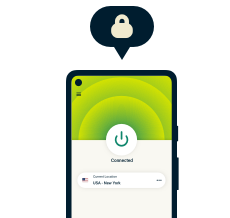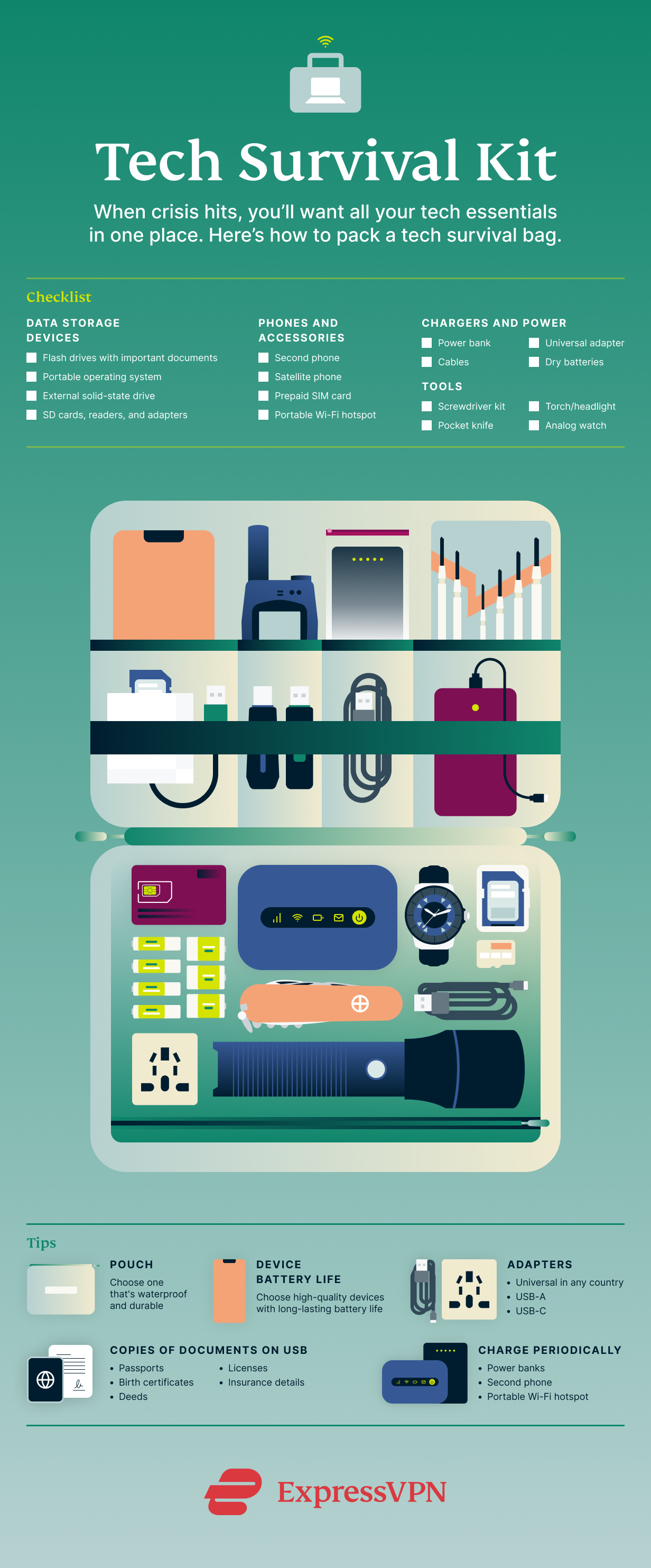Building any type of survival kit, be it a go bag or bug-out bag, is an important undertaking in preparedness. When crisis hits, just grab it and go.
This post, however, will focus purely on creating a tech pouch that you can include in your existing survival backpack. Ideally you’ll want to create a kit that covers a wide range of items to be used in broad scenarios.
While these are physical devices and tools to have on you, it’s always a good idea to have a VPN on your phone to reach the uncensored internet, no matter what crisis you find yourself in.
What is an emergency tech kit?
Some people pack “go” bags or survival kits in their preparation for crises such as natural disasters or man-made threats to their home. The purpose is to have essentials ready that they can easily grab and go, in the event that they need to evacuate quickly. And in an ever-connected world, tech gear has become an important part of these preparations.
What we list in this article are our recommendations of tech items to pack in your go bag to make any survival situation more successful and smooth, whether it’s items that supply you with information, allow you to stay in communication, or provide important survival resources like light. While tech gear might seem secondary to essentials like food and water, it can certainly improve your chances of survival.
Tech survival kit essentials
While you’ll want to tailor your kit to your own needs, here are must-have inclusions for your tech survival kit.
Select a pouch and organizers
You’ll want to store all of your emergency tech items inside a small pouch that’s both waterproof (or at the very least water resistant) and durable. If you can’t find a waterproof pouch, you could consider purchasing a waterproof duffel or storage bag at your local sporting goods store and placing your tech pouch inside that instead.
Durability is important as you’ll want your kit to be able to withstand rough treatment. Don’t sacrifice quality for price; you’ll want this kit to last you as long as possible.
Data storage devices
- Flash drives for important documents. This flash drive includes digitized important and sensitive documents to prove who you are and what you own. For safety, it is recommended this flash drive should be encrypted before usage. Important documents to be added could include: Passports, birth certificates, deeds, licenses, insurance information, accreditations, etc.
- Medical flash drives. This flash drive should not be considered a replacement for an emergency medical card but rather to be used in conjunction with it. The idea here is to create a USB stick only with relevant medical information should you be caught in an accident. This includes your name, emergency contacts, blood type, known medical conditions, and your medical history.
- External solid-state drive. You never know when you may need a drive to store, share, or copy files with others! Solid-state drives are preferable—rather than traditional external hard drives—as they are much faster.
- Portable operating systems. If you don’t have immediate access to a device that you own—i.e. if you’re in an internet cafe or library—then a lightweight portable Linux flash drive would come in handy as a safe way to use a computer while traveling.
- SD cards, readers, and adapters. Again, better to be prepared than not!
Chargers and power
- Portable power banks. Whether you’re waiting for emergency services to arrive or streaming sports on a painfully long train commute, the last thing you need is for your device’s battery to fully deplete. A good power bank will last a few months unused on a full charge. If possible, opt for waterproof options. If you can’t find any waterproof options, you can place your power banks inside durable ziplock bags. For an extra level of convenience, you can also look into power banks with wireless charging features to help cut down on the use of extra cables.
- Cables. It’s a good idea to have both data transfer and charging USB cables. This is because while you can use both types for charging your devices, some cables aren’t so great for transferring data. Further, as an extra consideration for security, you’ll want to ensure that you use cables purely designed for charging devices if you happen to be using a publicly provided USB slot—like the ones in train stations, cafes, and airport lounges. Given that devices you own may have different USB ports and requirements, you should also get multi-adapters that you can use for charging your devices.
- Universal adapters. Investing in several universal, or travel, power adapters is a great way to ensure that you can easily charge your devices whether you’re at home, on the go, or abroad. It’s best to go for options that provide the capability to work in as many locations as possible—in other words, opt for adapters with sliders that allow you to modify its plugs for any country. You’ll also want to consider options that include USB-A and USB-C charging ports.
- Dry batteries. In addition to the specialized items listed below, it’s always good form to carry various spare dry batteries or button cell batteries—e.g., AA, AAA, C, and D.
Phones and accessories
- Secondary mobile phone. A cheap secondary phone can come in handy if you’re abroad and still want to use your primary SIM card whilst roaming. It can also serve as an emergency device if your primary phone is damaged.
- Satellite phone. These are perfect in situations when you need to make emergency calls and your cell phone is out of range. Do note that you’ll need a subscription to an actual service in order to use them to make calls.
- Prepaid SIM card kit. A prepaid SIM card with preloaded credit can be used in your secondary phone. Most kits come with adapters for various SIM types (micro, nano, and mini SIM) and a SIM ejector (which is absolutely invaluable). If possible, opt for a SIM card with international allowances.
- Portable Wi-Fi hotspot. The upside to a portable Wi-Fi hotspot is that you won’t have to worry about draining your smartphone’s battery while tethering. A good portable Wi-Fi hotspot can support up to 10-15 simultaneous devices at a time.
Tools
- Screwdriver kits. Whether you’re performing laptop surgery or just fixing up minor mechanical issues that you come across, screwdriver kits are a killer asset to your tech survival arsenal. While they’re compact, they contain so many useful tools that it’s hard to imagine not purchasing one. These can be purchased at most computer markets or online retailers. Generally speaking, you can also take these on flights, but this may vary between airlines.
- Pocket knives—like Swiss Army-knives or other similar multi-tool knives—are perfect for stripping and cutting cables, opening packages, and general tech repairs. Ideally you’ll want to obtain one that’s stainless steel or high carbon, and has robust safety features like a strong locking mechanism.
- Lighting. There’s nothing worse than working on something that you’re having trouble seeing. Especially so when you’re performing something as delicate as tech repairs. A good headlamp or necklight would solve that issue straight away. Additionally, you can never go wrong with a good torch. Go with something compact, waterproof, and with at least 200 lumens.
- Diving watch. An analog diving watch is the perfect timekeeper for your survival kit. In addition to being waterproof, it won’t need to be charged (unlike a digital or smartwatch); in some cases a battery replacement would last up to years. And an in-built compass bezel will give you a rudimentary indication of your position when orienteering.

Take back control of your privacy
30-day money-back guarantee



























Comments
I may have missed it, but a “Print” option that gives the list without all 14 pages would be cool. Good article. Thanks!
How about giving some recommended items (like the carrying case). Obviously you have researched the items you recommend, save folks the trouble and put a few options by each item you list. Thanks.
I would like to know if there is a router that has a firewall in it that has a kill switch and I’m running on an iPad Wi-Fi only iOS many six generation I also have an AT&T iPhone 12 I need some type of a router for my situation because I’m still under a data bridge in a tech but the attackers are using routers and firewalls so to have just if if piano is not enough can you please recommend to me what I can do which routers best because trying to navigate the app they’re telling me I need to delete an MDM server they have deleted it before for me but they attack or just keeps redoing the fix they not redoing destroying whatever I call to get support for infix